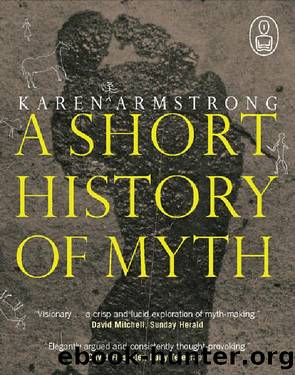A short history of myth by Karen Armstrong

Author:Karen Armstrong [Karen Armstrong]
Language: eng
Format: epub
Tags: Religion
ISBN: 9780676974249
Published: 2006-08-15T10:00:00+00:00
But Confucius realised that this could not be done by an act of will or by rational reflection alone. Absolute transcendence of selfishness could only be achieved through the alchemy of ritual and music, which, like all great art, transfigures human beings at a level that is deeper than the cerebral.76 Yet it was not enough simply to attend the rituals: it was essential to understand the spirit behind them, which inculcated an attitude of âyieldingâ (rang) to others in order to overcome pride, resentment and envy.77 As the worshippers bowed to the other participants, submitted to the demands of the rite, and allowed others to take the lead when required â all to the accompaniment of sublime music â they learned how to behave to their fellows in ordinary transactions and relationships. Confucius looked back to exemplary models of the past. The Chinese had no stories about the gods, but they did revere culture heroes, who were in fact mythical figures but were thought to be historical. Confuciusâs special heroes were two of the five Sage Kings of remote antiquity. The first was Yao, who had not only taught the Chinese the proper use of ritual and music, but had demonstrated the virtue of rang. Because he deemed none of his sons worthy to rule, he chose the virtuous peasant Shun as his successor. Shun had also displayed exceptional selflessness when he had continued to love his father and brothers and treat them with reverence and respect, even though they had tried to kill him.
But for Confucius, ritual, if properly understood, was more important than these mythical stories. There had been a similar development in Vedic India, where the rituals of sacrifice had eclipsed the gods to whom they were offered. The gods gradually retreated from the religious consciousness, and the ritual reformers of the eighth century BCE devised a new liturgy that put the solitary individual at centre-stage. Henceforth men could not rely on the gods for help; they had to create an ordered world for themselves in the ritual arena. The power engendered by these ceremonies, which was known as Brahman, was experienced as so overwhelming that it was thought to be the ultimate reality that lay beyond the gods and kept the world in being. Even today, a religious festival can produce the rapture that Indians call anya manas, the âother mindâ that is quite different from normal, profane consciousness. The Indian and Chinese emphasis on liturgy reminds us yet again that myth cannot be viewed in isolation from this context. Myth and cultic practice are equal partners, both help to convey a sense of the sacred, and usually do so together, but sometimes ritual takes first place.
The Axial Sages all insisted on a third component, however. To understand the true meaning of the myth, you must not only perform the rites which give it emotional resonance, but you must also behave in the correct ethical manner. Unless your daily life was informed by what Confucius called ren, rang and shu, a myth like that of Yao or Shun would remain abstract and opaque.
Download
This site does not store any files on its server. We only index and link to content provided by other sites. Please contact the content providers to delete copyright contents if any and email us, we'll remove relevant links or contents immediately.
Cecilia; Or, Memoirs of an Heiress — Volume 1 by Fanny Burney(32080)
Cecilia; Or, Memoirs of an Heiress — Volume 3 by Fanny Burney(31471)
Cecilia; Or, Memoirs of an Heiress — Volume 2 by Fanny Burney(31422)
The Great Music City by Andrea Baker(30801)
We're Going to Need More Wine by Gabrielle Union(18648)
All the Missing Girls by Megan Miranda(14805)
Pimp by Iceberg Slim(13808)
Bombshells: Glamour Girls of a Lifetime by Sullivan Steve(13706)
Fifty Shades Freed by E L James(12929)
Talking to Strangers by Malcolm Gladwell(12898)
Norse Mythology by Gaiman Neil(12866)
For the Love of Europe by Rick Steves(11582)
Crazy Rich Asians by Kevin Kwan(8903)
Mindhunter: Inside the FBI's Elite Serial Crime Unit by John E. Douglas & Mark Olshaker(8727)
The Lost Art of Listening by Michael P. Nichols(7172)
Enlightenment Now: The Case for Reason, Science, Humanism, and Progress by Steven Pinker(6884)
The Four Agreements by Don Miguel Ruiz(6330)
Bad Blood by John Carreyrou(6286)
Weapons of Math Destruction by Cathy O'Neil(5854)
